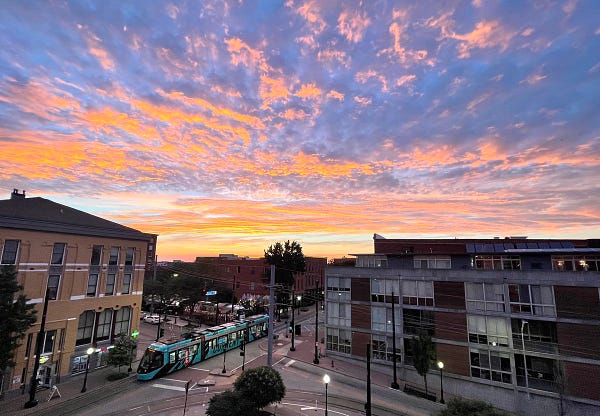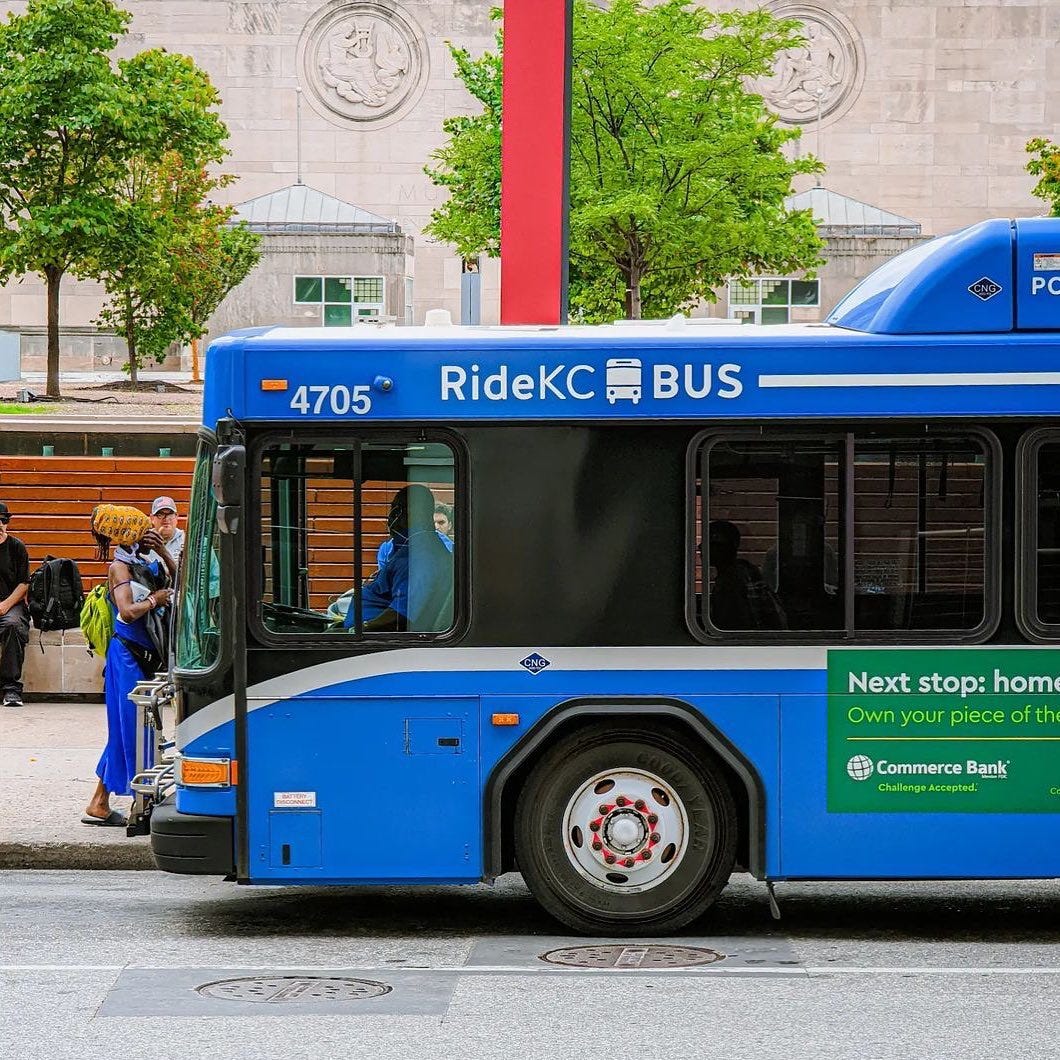Happy Independence Day weekend, Loopers!
Recently, I applied for, and was accepted to participate in, an international cohort group of Substack writers (Substack is the platform on which we publish The Loop). We have weekly, two-hour Zoom conferences during which we learn best practices, brainstorm ideas, and reflect on our own publications.
Last week, we were challenged to answer two questions:
Who are you writing for?
Why are you writing what you write?
I wanted to share my answers with you, and ask for your feedback as well.
Who is The Loop writing for?
If you are a reader here at The Loop, you are possibly…
a Downtown resident, worker, frequent visitor, or future Downtowner
seeking a connection to Downtown and our city
someone who is civic-minded and interested in making Downtown a better place for all
concerned about housing, homelessness, diversity, inclusion, affordability, and other social and economic issues affecting the Downtown (and larger) community
interested in mass transit, bicycling, walking
someone who appreciates the aesthetics, art, and architecture of cities
wanting to stay up on current events related to Downtown in the areas of development, culture, entertainment, dining, and more
a fan of local history
someone who takes pride in Kansas City
Why is The Loop writing what it writes?
The KC Downtown Loop provides a connection between readers and:
the place,
the history,
the community,
and the potential that is Downtown KC
I feel like the more you know about the place where you live, the more you can enjoy it, the more you take ownership, and the more you can make a difference. The Loop hopes to provide knowledge and connection, along with novelty and entertainment.
Who are you, dear reader, and why do you read The Loop?
Would love to know more about you and your motivations to read and subscribe to The Loop. Please use the comment button below to share where you currently call home and anything else you’d like to share, what brings you to The Loop, and maybe your favorite sections of The Loop or other things about what we do? Add any other comments as well, such as your favorite places Downtown, favorite memories, greatest concerns for Downtown, suggestions for the publication, etc. Your comments will appear to anyone reading The Loop, but we’re all friends here, so post away!
It was on today’s date in 1869 that one of the most important factors in the development of Kansas City as a major American city occurred. One hundred and fifty-three years ago, on July 3, the Kansas City Bridge—better known later as the Hannibal Bridge—opened as the first permanent rail crossing of the Missouri River anywhere in the United States.
But I want to stop right there for a moment. Although I’ve heard stories of the Hannibal Bridge many times in my lifetime, there is another bit of news here that I’d never heard of before. It happened the day before the bridge-opening celebrations, and seems to deserve more attention than this front-page mention gave it in the July 3, 1869, issue of Kansas City’s Daily Journal of Commerce.

And that’s all that was said about the tremors. Apparently there wasn’t a lot of concern about running a 19th-century train across a brand-new bridge spanning the untamable Missouri River the day after an earthquake….
So, we move on.
In the 1850s and ’60s, towns up and down the river knew that whichever community landed a railroad bridge would have a head start on development, and would likely become the pre-eminent metropolis along the Muddy Mo.
Having learned in 1866 that nearby Leavenworth, Kan., had already started the wheels in motion to bring the railroad and accompanying bridge through its city, community leaders in the frontier town of Kansas City devised their own plan to secure the economic catalyst for their burg.

As legend has it, KC sent Pennsylvania-born Kansas City leader Kersey Coates and other local leaders to Boston to persuade the Hannibal & St. Joseph Railroad directors to delay a decision on where their Missouri River bridge would be located.
Having allegedly secured an extra day, Coates sent word to R.T. Van Horn, another Kansas City community leader who was then a member of Congress in Washington, D.C., telling him that a decision would soon be made by the railroad. Van Horn amended a federal bill already under consideration regarding Mississippi River railroad bridge locations to authorize Kansas City as the location for a Missouri River bridge, and got it passed within a few weeks.
Another version of the legend suggests that Van Horn got the bill passed during the absence of any representatives of Kansas on the House floor.
No matter the facts, construction of the Kansas City Bridge began the next year under the guidance of civil engineer Octave Chanute.

When the bridge opened, Kansas City celebrated in ways not seen before in the small Missouri town. Although the city population was only around 30,000 at the time, reports were that 40,000 people showed up to witness the spectacle surrounding the christening of the bridge. There were parades, picnics, banquets, fireworks, and hot air balloons, along with the requisite speeches made by community and railroad dignitaries.
Kansas City’s Daily Journal of Commerce reported that “As a whole, the celebration on Saturday passed off well.” There was, however, some sort of incident at which some esteemed visitors from St. Louis and Chicago were apparently served “rot gut whisky,” and the newspaper apologized on behalf of the community:
“Kansas City is a small town compared with Chicago and St. Louis, and we are not accustomed to entertain as many distinguished gentlemen as favored us with their company,” the newspaper wrote. “But our intention was good, and we hope hereafter if we should again have occasion to extend hospitality to guests so highly esteemed, our performance may come nearer up to the mark of our desires.”
Overall, the Journal summarized the grand opening prophetically: “It was a great day in the history of Kansas City, and will long be pleasantly remembered.”

To illustrate the effect of the railroad crossing at Kansas City (critical among other factors in the growth of the city), Kansas City’s population in 1860 was just short of 4,500 residents. By 1900, the city was home to more than 163,000 people.
The first Hannibal Bridge was replaced in 1917 by the second Hannibal Bridge, which still exists today for railroad traffic.
More commentary about Kansas City’s successful bid to host the World Cup in 2026. “The announcement was not so much of a culmination as it was a green light to keep preparing. At least four World Cup matches—and perhaps five to seven—are to be played at Arrowhead Stadium, the city’s 76,000-seat NFL facility.” More from The Guardian:
Link: How Kansas City became the 2026 World Cup’s most unlikely host city
Always love seeing new angles—and amazing Downtown skies:
River Market Antiques is hosting an Ice Cream Social & Hot Summer Sale Saturday, July 9. Soft-serve ice cream and toppings bar with a building-wide sale. Details here:
Link: River Market Antiques Ice Cream Social and Hot Summer Sale
If you follow The Loop, you probably know that I’ve been frequently riding the bus to and from my office. The Kansas City Star recently shared an article about the costs associated with driving versus taking public transportation, so I thought I’d share these two links for you to calculate your own situations:
Link: How much does driving cost you? (KC Star $)
Link: RideKC’s “True Cost of Driving” Calculator
My yearly estimated cost of commuting by car is $1264. By selling one of our two cars in 2020, we are projected to have saved an additional $6,624 in car ownership cost per year (full-coverage insurance, license, registration, taxes, depreciation and finance charge).
Planning and discussion continue around a proposed streetcar extension from Downtown to North Kansas City. Last week, officials held a “NorthRail” meeting to share concepts and get feedback. Here is more information and imagery:
Link: NorthRail Public Meeting – June 28, 2022
1900


Artful City: One weekly selection with a Downtown connection

Quick Clip: The city in motion—just a few seconds at a time

Downtown Lens: A single image depicting the urban aesthetic

Answering the question “Who are all these people and where are they going?”, The Loop brings you a list of some of the biggest events happening Downtown each week. Please give a friendly Downtown-Kansas City welcome to audiences and attendees of….
TODAY
Challenge 2022 continues through the 7th at Bartle Hall
Dirty Heads at GrindersKC
MONDAY the 4th
Rod Wave at the T-Mobile Center
FRIDAY the 8th
Machine Gun Kelly at the T-Mobile Center
SATURDAY the 9th
Dino and Dragon Stroll continues through the 10th at Bartle Hall
Eddie B at the Midland
For a more exhaustive list of everything happening Downtown, go to the VisitKC events page and use the “regions” function to search for Downtown, Westside/Southwest Blvd, West Bottoms, River Market, Power & Light, Crown Center, Crossroads, 18th & Vine—or anywhere you want to go in the KC Metro
Until next week—enjoy the city! 🚃

Got a tip or question about Downtown KC?
Write to: tips@kcdowntownloop.com or contact The Loop via social media
Kevin Worley, Co-Publisher/Editorial
Joe Nichols, Co-Publisher/Business
Hannah Schuh, Intern
107 W. Ninth Street, Suite 210
Kansas City, MO 64105
Give The Loop a boost: Become a Founding Subscriber
In addition to having access to all content, and receiving invitations to The Loop’s Downtown events, Founders Level subscribers ($200 annually, or any amount above) receive a Downtown Loop sticker, a T-shirt in their choice of fit, size, and color, and recognition on the website.
THANK YOU TO THESE FOUNDING SUBSCRIBERS….
Chris Gahagan
The Kiwinda-Tinsley Family
Todd and Donna Martin
Jane Reed and Mark Patterson















Did you notice that, in the photo of the Gillis House Hotel (as people commonly refer to it now) the hotel is adorned with a sign saying GILLISS HOUSE. Wonder what happened to that second S?
historical context is good and important for setting place.